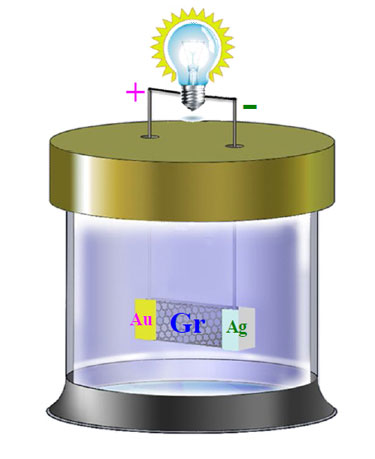Graphene Battery Turns Ambient Heat Into Electric Current
From:http://www.technologyreview.com/view/427140/graphene-battery-turns-ambient-heat-into-electric-current/
Physicists have built a graphene battery that harvests energy from the thermal movement of ions in solution

Here’s an interesting idea for a battery. The thermal velocity of ions in aqueous solution is huge–hundreds of metres per second at room temperature. And yet few people have studied this process or its potential to generate current.
Step forward Zihan Xu at The Hong Kong Polytechnic University and a few buddies who have not only studied this process but seemingly mastered it too.
These guys have created a circuit consisting of an LED connected to a strip of graphene by some wire. They simply placed the graphene in a solution of copper chloride and watched. Sure enough, the LED lights up. (Actually, they needed six of these graphene circuits in series to generate the 2V needed to make the LED light up but you get the picture.)
Here’s what’s going on, according to Zihan and co. The copper ions, which have a double positive charge, move through the solution at a rate of about 300 metres per second thanks to the thermal energy of the solution at room temperature.
When an ion smashes into the graphene strip, the collision generates enough energy to kick a delocalised electron out of the graphene.
The electron then has two options: it can either leave the graphene strip and combine with the copper ion or it can travel through the graphene strip and into the circuit.
It turns out that the mobility of electrons is much higher in graphene than it is through the solution, so the electron naturally chooses the route through the circuit. It is this that lights up the LED.
“The released electrons prefer to travel across the graphene surface…instead of going into the electrolyte solution. That is how the voltage was produced by our device,” say Zihan and co.
So the energy generated by this device comes from ambient heat. These guys say there were able to increase the current by heating the solution and also by accelerating the copper ions with ultrasound. They even claim to have kept their graphene battery running for 20 days on nothing but ambient heat.
But there’s an important question mark. One alternative hypothesis is that some kind of chemical reaction is generating the current, just as in an ordinary battery.
However, Zihan and co say they ruled this out with a couple of control experiments. However, these are described in some supplementary material that they do not appear to have put on the arXiv. They’ll need to make this available before others will take the claim seriously, of course.
Taken at face value, however, this looks to be a hugely important result. Others have generated current in graphene simply by passing moving water over it, so it’s not really a surprise that moving ions can do the job as well.
It raises the prospect of clean, green batteries powered by nothing but ambient heat. As Zihan and co modestly put it: “it represents a huge breakthrough for the research of self-powered technology”.
Let’s hope they’re right. But for the moment at least, the jury must remain undecided.
Ref: arxiv.org/abs/1203.0161: Self-Charged Graphene Battery Harvests Electricity from Thermal Energy of the Environment